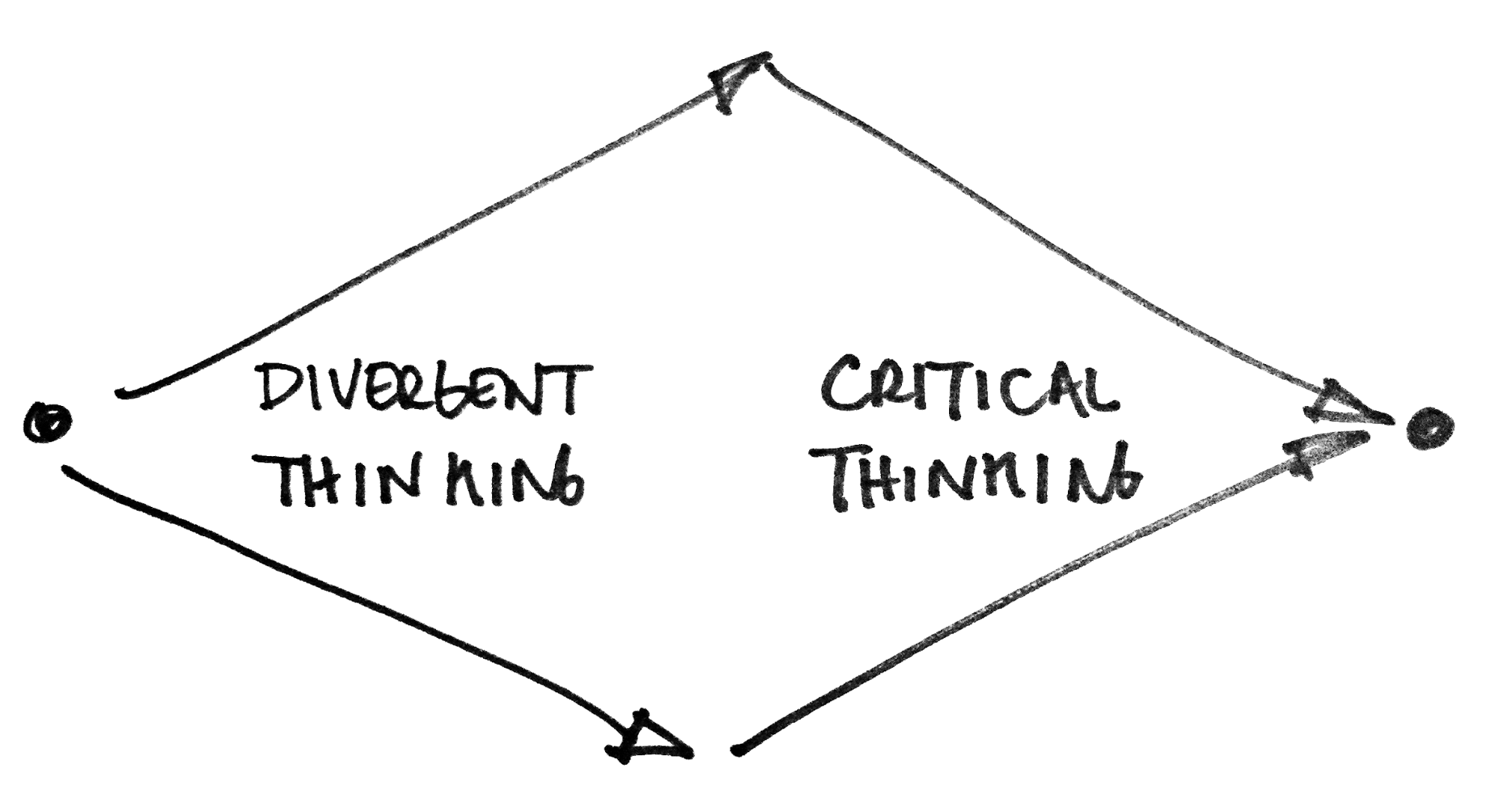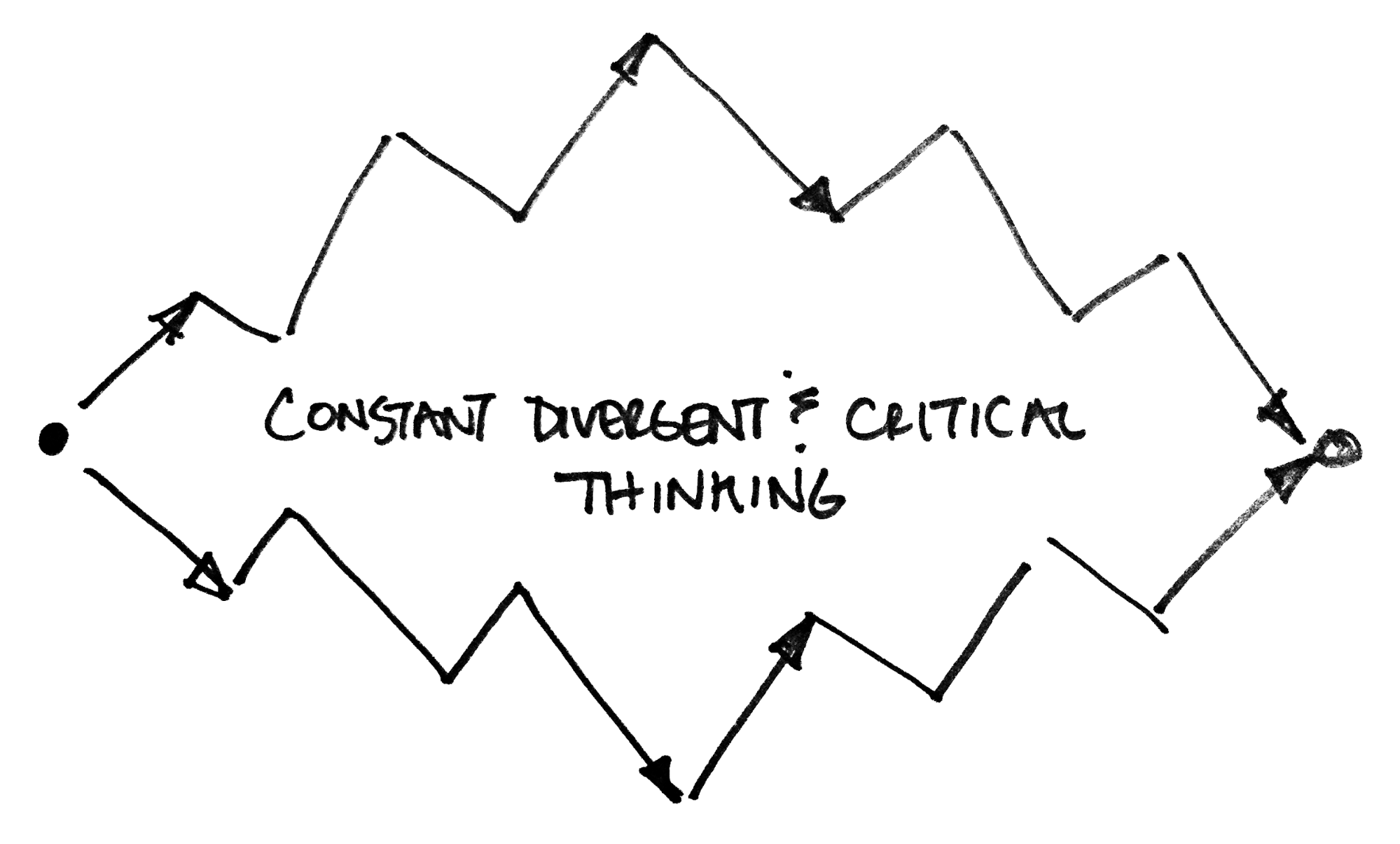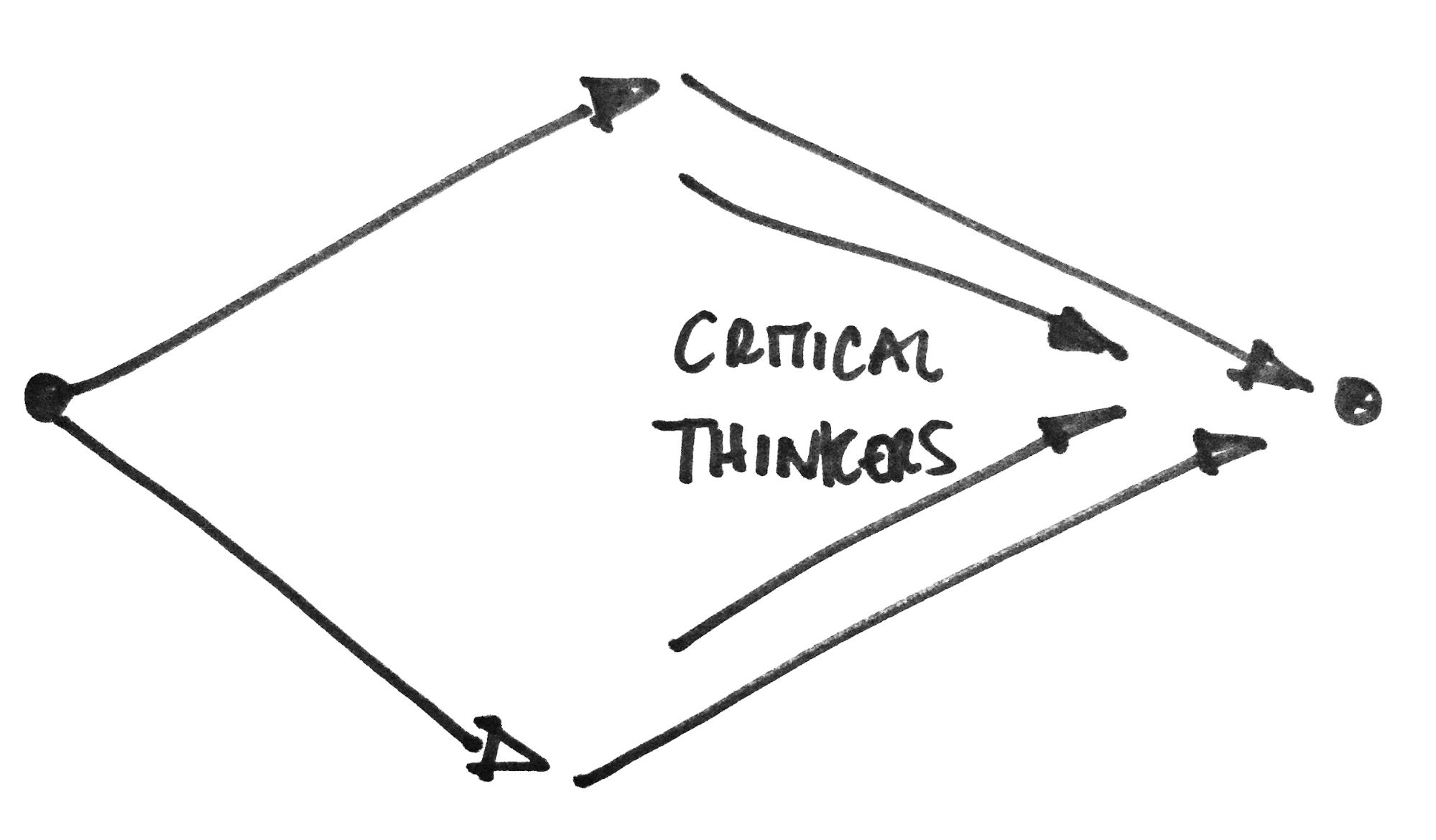It was 1997 and Steve Jobs was in the beginning of plotting a resurrection of Apple. 'We're back' was the advertising campaign that would kick it all off. Only Steve realized that the Apple board's approval of this campaign would be a complete disaster. They weren't back. It wouldn't be for another year that the iMac revolution would kick off the most amazing hit parade of products that were ever produced.
Steve pushed and prodded to change the ad that eventually gave way to one of the most iconic ad campaigns ever created- 'The Crazy Ones'. It was a beautiful tribute to those that dared to change the world, to Think Different. Apple would be 'back', only he didn't have to say it, he could show it. It wasn't a directive, it was a challenge for the company. The ad created a stage for the company to surprise and delight its fans. There was no mention of products and it made no direct reference to Steve's return. From the board's perspective, it was a critical thinker's nightmare- how the hell was this solving a problem?
Steve's Think Different Company
The advertisement was a signal that Apple was focusing on its core strength, but it made no promises as to what that result was going to be. Steve just knew there would be an outcome that would be significantly better than the situation they were currently in based on hard work and reducing their product line. To pull this off, he needed every employee to believe that this turnaround would be great, but he had no guarantees that any of this would work. It was a huge gamble.
To punctuate the irreverence of this campaign, Apple quite literally chose to ignore grammar all together by dropping the 'ly' off the slogan, 'Think Different.' It was a bold campaign that committed Apple to a bold approach that would be the anti-IBM's 'Think' campaign. It was a marvelous concoction that shot an arrow at the plain thinking competition, planted a seed in every employee's head, and gave fans hope that something amazing was about to unfold. Yet none of it existed. The ad campaign helped him create a problem space for people to find answers, most importantly for the employees in his company.
Bringing Divergent Thinking to the Company
Steve was trying to do the unthinkable- get his large, failing company moving and thinking in divergent ways. The first place he started was to attract talent that would believe in wicked ideas. The other was to get existing employees to open up their minds to creative possibilities. In one of my previous posts I tried to debunk the idea that right brain thinkers have a magic touch or ability to come up with creative ideas. Much of what we learn about creativity can be taught, but it's difficult for most people to overcome the hurdles that have slowly been built over time.
In design, we continually open and close down problems through methods that can confuse many critical thinkers in a business. In most cases, this type of thinking can be trained, but it can be a frustrating experience. Research validates why this is so hard.
Of 1,600 children aged three to five who were tested, 98% showed they could think in divergent ways. By the time they were aged eight to 10, 32% could think divergently. When the same test was applied to 13 to 15-year-olds, only 10% could think in this way. And when the test was used with 200,000 25-year-olds, only 2% could think divergently . . . Education is driven by the idea of one answer and this idea of divergent thinking becomes stifled. Sir Ken Robinson
In our own company we've used Progressive Design to help both design thinkers and critical thinkers open themselves up to divergent thinking. It's an area I've focused on as a design leader for nearly two decades, trying to find ways to bring critical thinkers into a design thinking mindset. It's not easy, and Steve was able to pull this off without even having to address the design problem. It just was. Except, with closer scrutiny, that's not really true.
Lead by Design
As a design practitioner and leader who practices design across all facets of the organization- strategic, tactical and operational- I've come to find divergent thinking creates the biggest divide and the most frustration for workers trying understand how to work and design together in their organizations. Divergent thinking and critical thinking are both necessary to drive a creative and disruptive business agenda. If a company truly wants to be design centric in their approach, and current trends say they do, they need to understand how divergent thinking affects all their decisions, even if they are still using critical thinking to arrive at an answer. Steve understood this idea.
Which gets us to our current situation in design. Designers are still struggling to pull their companies forward. If designers want to make changes in their organizations, we're going to have to lead by design. We're going to need to have a lot of empathy for our coworkers, and we're also going to have to create structures for people to work within. There's no other way to say this other than 'it is going to be very uncomfortable for many organizations.' Building a design centric organization requires embracing the awesome critical thinking people in it, but here's the hard part, within the context of divergent thinking across the business.
Now melding thinking styles creates a real problem for designers- imagine telling a strong willed CEO or leader who is a critical thinker to work within a new framework for thinking. Try telling a leader their thirty years of work experience is super valuable, but you need it in the context of 'your' thinking reality distortion field called design. Without a healthy dose of critical thinking skills, that's going to be a struggle, if not impossible. Sure, you can point to some snazzy business article as reference, but you're going to be hard pressed to get people quickly onboard with this thinking. That conversation requires extreme vulnerability.

| How your typical Design Thinker needs a design process to go: | How your typical Critical Thinker sees a design process: |
| 'Let's open up the problem so that we can figure out the right problems to solve before we try to rush to an answer.' | 'Just do your thing so that I can straighten out your mess. We have a deadline and need to solve this problem' |
| Ways to look at divergent thinking: | Ways to look at critical thinking: |
| Enhance Defer Judgement Go big and wide Generate Fantasize Build on others 'yes, and'' Explore Imagine Enlarge perspectives Visualize Increase Combine and Integrate Engage Possibilities Play with Seek out the unusual |
Clarify Decrease Categorize Refine Rate by Criteria Make sense of Select Affirmative judgement: discernment Guidelines Decisions Contract Hone in ?focus Reduce Connect Cluster |
The Genius of Steve
Steve understood that the odds of moving everyone forward with a divergent thinking approach was impossible- but he didn't need to get everyone to think this way. By the time his second stint at Apple came around in the mid nineties, the computing industry was beginning to understand that competing on features was starting to be a race to the bottom. Knowledge workers were starting to get that there were diminishing returns on the incremental speed that computing power could provide. IBM wanted us to think. Steve wanted us to think differently.
The bar was so low that Steve knew incrementally attracting more than the standard 2% of divergent thinkers would provide the necessary culture push for Apple, and all it's fans, to believe it truly could think differently. If you had a Mac, you didn't have to be part of the drab, cubicle thinking business worker. And if you looked at any of their products that continued to run off the factory belt, they all appeared to embody a different, well done finish. Asking all his employees to think differently wasn't necessary, he had them feeling like they were thinking differently. In Steve's world, he only needed his critical thinkers to be open minded to this concept and feel connected to this way thinking.
On the surface, critical thinkers in the company felt like they were a big part of the equation. Creating a culture that supported divergent thinking is what gave Steve the space to help these critical thinkers work within the sometimes chaotic world of design thinking. On the surface, critical thinking appears to be just part of the daily work grind- what makes these worlds collide and create stress is the constant opening and closing of problems. This is where a critical thinker quickly gets lost and frustrated. The culture is what helps alleviate parts of this frustration. It becomes the norm.

What Designers Need To Do Next
Recent, conventional business trends like GTD, or Getting Things Done, have been all the rage in recent years. GTD is a very process driven approach to help people blaze through task lists and priorities to create a compound effect thats leads to bigger impact. While these techniques help people create incremental gains, it's still a very critical thinking way to solve problems. So when the need for bigger thinking arises, these techniques eventually just help us pump out shit, just in greater quantities. They help us 'Think,' just the way IBM thought.
This is where divergent thinking can help us break through conventional business practices and process.
The success of the elite worker will depend upon that person's ability not to get things done, but to have breakthroughs'''to use access to knowledge and automation to deliver explosive ideas. To do that which only a human can do.David Kadavy
It's such a simple idea. At ZURB our mantra had been 'Design for People' for over a decade. On the surface it is meant to express our desire to help our customers focus on their customers, but it goes a level deeper in that we're setting up people in our business to design effectively. Our peeps must have the guts to breakout of conventional trends to design what is best for our customers.
Instead of getting stuck working from the mindset of a critical thinker, a divergent thinker needs to create an environment of support to help employees work in a creative and divergent way. Designers are uniquely positioned to help organizations, though the effort requires a strong willed and empathetic designer. It means closing gaps. This is what it truly means to lead by design.

Critical Thinkers in a Design Thinking World
People are the key to thinking differently and need to feel they have freedom to do so. Housing critical thinking within the bounds of divergent thinking plays to the strengths of both camps and ensures organizations can continue to stay innovative. Divergent thinkers are free to expand ideas and explore new frontiers unencumbered while critical thinkers are able to pull in the reigns when necessary from within, keeping focus without being unduly restrictive.
Erecting this structure in organizations can only be done by divergent thinkers, and designers have the greatest chance of doing it successfully given their ability to empathize with people. Notice I say 'chance' because their inexperience as an industry in managing people (particularly non-designers) runs the real risk of foiling their efforts. Many designers will quickly become discouraged and disillusioned by the resistance they will undoubtedly encounter and give up. But an anitfragile designer that is motivated to create lasting impact, who aspires to be more than simply a master of their craft but a master of outcomes, will have the wherewithal, passion, and long-term thinking necessary to successfully lead this transformation.

Bryan Zmijewski
Leading the charge at ZURB since 1998
Our fearless leader has been driving progressive design at ZURB since 1998. That makes him quite the instigator around the offices, consistently challenging both the team and our customers to strive to always do better and better.
Learn more '
Follow him at @bryanzmijewski
